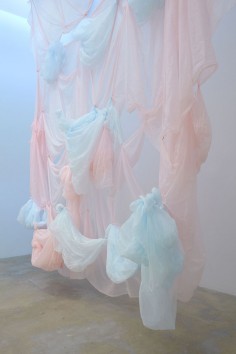Karla Black
source: saatchigallery
Karla Black’s work draws from a multiplicity of artistic traditions from expressionist painting, land art, performance, to formalism. Her large-scale sculptures incorporate modest everyday substances, along with very traditional art-making materials to create abstract formations. Black chooses her media for their tactile aesthetic appeal: the familiarity of the texture of cellophane or the scent of cosmetics bridges the experience of tangible matter with the intimacy of memory or the subconscious. Black’s process is intensely physical and this energy is conveyed through her work’s ‘impromptu’ staging; this suggestion of performance psychologically involves the viewer with the making process, provoking instinctive responses to her precarious assemblages.
.
.
.
.
.
.
.
source: icaphilaorg
Karla Black constructs large-scale, site-specific sculptures using amorphous yet everyday materials—from dirt, chalk, and dough to the powders, sprays, and gooey substances we use to coat our bodies. Her work reacts to the light and space of each site with a sense of play and indeterminacy. In forms that always seem to be on the brink of collapse, the unremarkable and commonplace are rendered transcendent through size and scale, grand abstractions infused with a sense of entropy.
Black’s working method is intensely physical and ideally solitary. That she is alone in the gallery for days, even weeks, to produce these sculptures is essential. Her body’s connection to the work is, she says, outside of language, and although her individual labor is not explicitly evident in the finished work, the act of moving and shaping these materials herself is at the core of her practice. Citing British psychoanalyst Melanie Klein—who theorized that young children could be analyzed by engaging in play rather than conversation—Black’s process celebrates the unconscious decisions and physical movements an artist makes while immersed in her chosen materials. Her hope is to elicit an equally visceral response from viewers, and the desire to touch her sculptures can often be overpowering. The materials cannot, of course, be handled, and the tension engendered in this desire is one that Black sees as essential to experiencing her work. The intense visuality, the sheer pleasure of color and shape, and the olfactory dimension permeating the gallery produce an engulfing, multi-sensory environment that make the work, in Black’s words, “almost painting, almost installation, almost performance art.”
Black has responded to ICA’s towering vertical space with Practically In Shadow (2013), a major, multi-part sculpture incorporating her largest hanging polythene object to date. Suspended among skylights, this prismatic structure will be continuously transformed through shifts in natural light, both dramatic and subtle. The floor element of the work amasses nearly 7,000 pounds of powdered plaster and paint, chunks of delicately-hued bath bombs, and a crown-like form crafted from cellophane.
.
.
.
.
.
.
.
source: arteseanpblogspot
Karla Black (1972-) Nasceu em Alexandria. Graduou-se em escultura na Glascow School of Art. Obteve o título de Mestre em Filosofia e em Artes na mesma instituição. Ela usa materiais do dia a dia como papel de vários tipos, plástico e tecidos coloridos com batons e outros cosméticos. São grandes e leves instalações abstratas. Foi influenciada por Helen Frankenthaler, Karen Kilimnick, Lynda Benglis, Robert Smithson and Richard Tuttle. Foi indicada para o Prêmio Turner.Participou das Bienais de Veneza e Bruxelas. A artista é representada pela Stuart Shave/Modern Art, Londres.
.
.
.
.
.
.
.
source: proholzat
Karla Black, geboren 1972 im schottischen Alexandria, studierte Kunst und Philosophie an der berühmten Glasgow School of Art. Eine ganze Reihe von international bedeutenden Künstlern ging aus der Akademie hervor, von den Glasgow Boys im 19. Jahrhundert über die realistischen Maler der achtziger Jahre bis zu jüngsten Turner-Preisträgern wie Richard Wright, Simon Starling und Martin Boyce.
Black machte vor zehn Jahren dort ihr Examen und lebt seither in der Stadt, ihre Wohnung und ein einsames Häuschen auf dem Land dienen als Ateliers, wo sie ausprobiert, mit Materialien spielt, Oberflächen testet. Ihr eigentliches Studio in einem Atelierhaus in der Innenstadt, wo Assistenten an größeren Skulpturen arbeiten, betritt sie nur selten, um an Details dieser Werke zu feilen.
Sie begann als Performancekünstlerin, zog jedoch nach und nach den eigenen Körper und dann auch direkte Anspielungen auf körperliche Formen aus ihrer Kunst ab.


